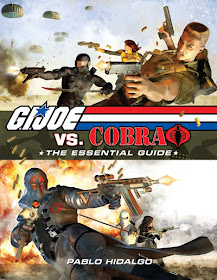At the risk of dating myself, the only G.I. Joe action figures (not "dolls!") were the original 12-inch ones. By the time the 3.75-inch figures came out, I was an adult--and well into my wargaming hobby (where I was playing with even smaller figures). I was vaguely aware of the cartoon series, but never watched it, while I never bothered to delve into any of the comic books.
Recently, I came across the Classic G.I. Joe, Volume 1 at Half Price Books, which is a compilation of the first ten issues. Because I'm always interested in origin stories, I decided to buy it.
For the most part, I enjoyed the book, although I'd definitely call this a "comic book" as opposed to a "graphic novel." While these two terms are often used interchangeably, I notice that comic books use exposition-as-dialogue far more often than graphic novels. I assume this is to cater to younger readers and the producers may feel they needed to explain the action within each illustration.
As an adult reader, who didn't grow up reading this comic series, I found the exposition-as-dialogue, not to mention the villainous monologues, to be rather annoying. However, I do like stories of good guys thwarting the bad guys and I knew what I was buying. So I'm giving this a solid, 3-star rating. Most of the reviewers on Amazon.com are 5-star ratings. The less-than 5-star reviewers were primarily miffed about several items being omitted, like a story called The Hot Potato from this volume, that were included in the original issues.
Another origin story, I found in the grapic novel section of Half Price Books was: GI Joe: The Rise of Cobra--The Official Movie Adaptation. Like the cartoons and comics, I didn't see the latest movie, which despite the luke-warm reviews, studio execs decided to produce a sequel next year.
Anyway, since the graphic novel was cheaper and more durable than a theater ticket or DVD, I bought this too. Interestingly enough, no one bothered to write a review on Amazon.com--so I guess this means I'll be the first!
I'll give this a 3-star rating. The authors took some liberties with the original characters, but I found it interesting how they portrayed the evolution of the recurring villains; Cobra Commander, Destro, Storm Shadow and of course--The Baroness--a favorite bad-girl among convention cosplayers...
Because my knowledge of G.I. Joe lore is lacking, I couldn't pass up the G.I. Joe vs Cobra--The Essential Guide.
Other Amazon raters weren't so charitable, with most of them giving this book a mere 3-stars. Like the superhero comics, the publishers of G.I. Joe devoloped a plethora of alternate storylines for the same characters. The Essential Guide attempted to tie all these together, much to the dissappointment of the critics.
So my high rating here, may be due to my lack of pre-conceived notions.
"Yo! Joe!"
























